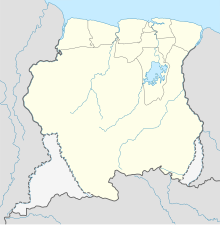An editor has nominated this article for deletion. You are welcome to participate in the deletion discussion , which will decide whether or not to retain it. |
Vier Gebroeders Airstrip | |||||||||||
|---|---|---|---|---|---|---|---|---|---|---|---|
| Summary | |||||||||||
| Airport type | Public | ||||||||||
| Operator | Luchtvaartdienst Suriname | ||||||||||
| Location | Vier Gebroeders | ||||||||||
| Elevation AMSL | 1,110 ft / 338 m | ||||||||||
| Coordinates | 1°57′45″N55°55′45″W / 1.96250°N 55.92917°W | ||||||||||
| Map | |||||||||||
Location in Suriname [1] | |||||||||||
 | |||||||||||
| Runways | |||||||||||
| |||||||||||
HERE Maps [2] | |||||||||||
Vier Gebroeders Airstrip( ICAO : SMVG), also known as Meyers' airstrip or Mamija airstrip, is and airport near Vier Gebroeders, Suriname. [3] The runway is on the border with Brazil.
